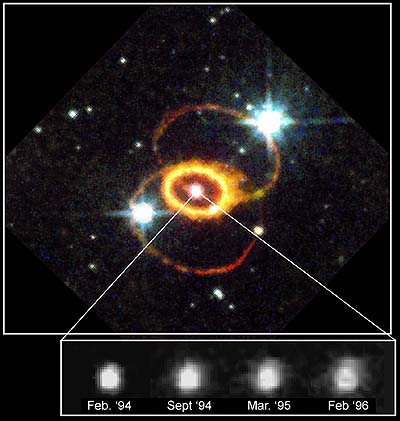Supernova 1987a Fireball Resolved

Credit & Copyright: C. S. J. Pun (GSFC)
& R. Kirshner (CfA),
WFPC2, HST,
NASA
Explanation:
Ten years ago the most notable
supernova
of modern times was observed. In February 1987, light reached
Earth from a star which exploded in the nearby
Large Magellanic
Cloud
galaxy.
Supernova 1987a
remains the closest
supernova
since the
invention of the telescope.
The
explosion
catapulted a tremendous amount of
gas,
light,
and
neutrinos
into interstellar space. When observed by the
Hubble Space
Telescope
(HST) in 1994,
large strange rings
were discovered whose origin is still mysterious, although thought
to have been expelled even before the main explosion.
More recent HST observations
shown in the inset, however, have
uncovered something actually predicted:
the expanding fireball from the exploding star. The
above high resolution images
resolve two blobs flung out from the central explosion.
Authors & editors:
Robert Nemiroff
(MTU) &
Jerry Bonnell
(USRA)
NASA Web Site Statements, Warnings,
and Disclaimers
NASA Official: Jay Norris.
Specific
rights apply.
A service of:
LHEA at
NASA /
GSFC
& Michigan Tech. U.

